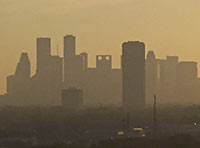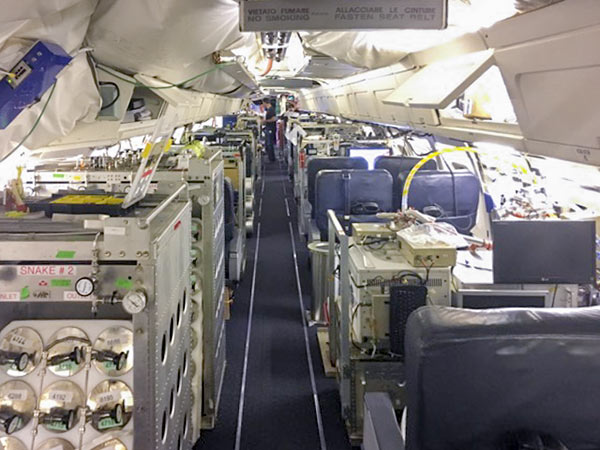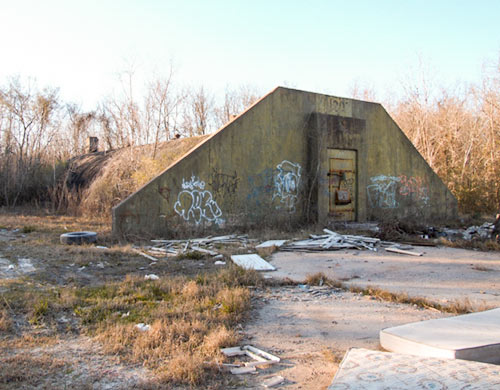HOW HOUSTON’S AIR GOT BETTER  During the past decade, Houston’s notoriously polluted air has become — well, if not quite good, then not quite as bad, says NPR’s Richard Harris. (Pay no attention to what that ozone app may or may not tell you.) How? Well, it seems that pollution regulators in the early aughts had been worrying about all the wrong gases: “They were going all-in against [only] one of the pollutants that create smog, while downplaying the role of other emissions from the petrochemical plants,” reports Harris. “Barges carting chemicals up and down the [Ship Channel] were leaking. . . . And some types of storage tanks were leaking as well. . . . It turns out that routine day-to-day emissions were not the biggest problem.” Since then, regulations targeting those chemicals, like ethylene — as well as the use of infrared cameras that can spot them — appear to have made a difference: Port of Houston Authority employee Dana Blume tells Harris: “I can look out of my office window now and almost every single day see downtown.” [NPR; previously on Swamplot] Photo: Flickr user stmu_mike
During the past decade, Houston’s notoriously polluted air has become — well, if not quite good, then not quite as bad, says NPR’s Richard Harris. (Pay no attention to what that ozone app may or may not tell you.) How? Well, it seems that pollution regulators in the early aughts had been worrying about all the wrong gases: “They were going all-in against [only] one of the pollutants that create smog, while downplaying the role of other emissions from the petrochemical plants,” reports Harris. “Barges carting chemicals up and down the [Ship Channel] were leaking. . . . And some types of storage tanks were leaking as well. . . . It turns out that routine day-to-day emissions were not the biggest problem.” Since then, regulations targeting those chemicals, like ethylene — as well as the use of infrared cameras that can spot them — appear to have made a difference: Port of Houston Authority employee Dana Blume tells Harris: “I can look out of my office window now and almost every single day see downtown.” [NPR; previously on Swamplot] Photo: Flickr user stmu_mike





As an Asthmatic in Houston, this is awesome news.
The air in Houston is better because I left town.
More help is on the way for Houston in the form of new emmissions rules for lawn equipment. Lawn mowers have no catalytic converters and emit piles of smog precursers. Adding catalytic converters to lawn equipment is like taking one in every five cars off the road in terms of smog reduction. Sen. Kit Bond for years blocked putting catalytic converters on lawn equipment on behalf of Briggs and Stratton, a US maker of lawn mower engines.
Nuttin’ wrong w/a wee bit of progress. Thank goodness for all the new Texas natural gas . . . time to shut down all the coal-fired plants in Texas . . . they ain’t needed anymore and most are antiquated grandfathered particulate-spewing CO2 belching little moneymakers . . . sucks to
own tons of coal.
Ummm…there’s a lot more science and detail to it than this oversimplified summary. Offhand, I can think of:
-Gas pump sleeves to prevent fumes
-Increasingly efficient vehicles
-More use of natgas for electricity production vs. coal
-Replacement of MTBE with ethanol as gasoline additive
-Switch to more “first world” industry in local economy vs. older, dirtier manufacturing and chemical plant production
-Better technology and emissions controls at plants that are largest sources of emissions
-Increased monitoring and enforcement of clean air laws
-Increased public interest and concern about local air quality
…and many, many more…
MTBE was not a contributor to air pollution. Ethanol is no panacea.
Another factor may be that when the Clean Air Act was signed into law in 1970, the scope of the mandate was so broad in scope that it authorized the EPA and states to regulate any and all emissions that are known to have detrimental impacts to human health. However, measurement capabilities are so much more advanced, 40 years later, that what can and is being regulated vastly exceeds what a cost-benefit analysis would indicate that should be regulated.
Actually MTBE makes engines run more efficiently, therefore creating LESS pollution. A bunch of lawyers found an old underground tank at a retail store leaking gas mixed with MTBE, sued for ruining groundwater, and the retail stations agreed to quit using it as octane booster. Now they use Ethanol which is much more expensive. MTBE is legal and used in every country in the world except the USA. It is interesting how we bring in oil, make gasoline, mix it with MTBE and sell it all over the world. This is the real reason gas is so high folks, it is sold on US dollar basis all over the world. Ethanol is now used in place of MTBE and has only about 65% of the heating value of gasoline, so you need more of it to go same distance, therefore causing MORE pollution. Blame the lawyers for high gas prices. the USA largest export is now finished refined products (diesel, gas, jet fuel, etc)
I would add that since the original clean air act was passed in 1975 that air emissions in the USA are down by 83%. Also since it was revised in 1990 air pollution is down over 60% and the economy almost doubled!. we are fighting for that last 10%
I like that movie Point Break when Busey says “LA has changed a lot since I moved here, the air got dirty and the sex got clean!!”
@Old School – I would like to see some data on the magnitude of lawn equipment emissions before supporting more regulations on that equipment.
In my case, I burn less than 1 gallon of gasoline in my lawn mower each month during the summer, when I mow once per week.
Meanwhile, I burn 30 gallons of gas in my truck each week (120 gal/month) commuting and driving around town. Even without factoring in the catalytic converter debate, that’s a ratio of less than 1 to 120 of lawn equipment vs. vehicle fuel consumption. I realize my case is not the standard, but still I’d like to see some actual data before we make the price of a lawn mower increase $50.
@superdave, just google lawnmower emissions. They are pretty bad. small engines don’t burn as efficiently as car engines, and there are lots of unburned hydrocarbons emitted. EPA has some information as well. Here’s a start http://www.straightdope.com/columns/read/2967/does-using-a-gasoline-powered-lawn-mower-produce-as-much-pollution-as-driving-an-suv-300-miles
What about all the hipsters on their Vespas with no catalytic converters and leaving white smoke cloud behind them while burning oil?
“In my case, I burn less than 1 gallon of gasoline in my lawn mower each month during the summer, when I mow once per week.
Meanwhile, I burn 30 gallons of gas in my truck each week (120 gal/month) commuting and driving around town. Even without factoring in the catalytic converter debate, that’s a ratio of less than 1 to 120 of lawn equipment vs. vehicle fuel consumption.”
From everything I’ve read, your lawnmower is probably putting out more emissions than your truck, even with the 1:120 ratio.
from wiki “The common name given to the atmospheric gases used in breathing and photosynthesis is air. Dry air contains roughly (by volume) 78.09% nitrogen, 20.95% oxygen, 0.93% argon, 0.039% carbon dioxide, and small amounts of other gases.”
The war is on CO2, it is an atmospheric gas, not a pollutant. It does have heat trapping characteristics, BUT common water vapor has more and is approximately 1% of our “air”. I just dont understand this war on CO2, more of it promotes more plant life, end of story. Also, Methane gas traps 20 times more heat than CO2, this is why gas pumps have rubber sleeves around them, the vapors escaping trap 20 times the heat than does CO2. Prepare for higher electricity costs since this war on CO2 and coal is going to cost us a lot of money.
Lawn machinery is also a terrific source of NOISE pollution. Catalytic convertors are nice, so would mufflers. And all leaf blowers should be consigned to hell.
benny, the thing of CO2 vs H2O in the atmosphere is that there is a distinct link between what we consume and the amount of CO2 in the air. So you can do a comparison vs the amount of carbon fuels used and CO2 rise. H2O in the atmosphere isn’t rising linked to our consumption.
I’d imagine if we switched over to the panacea that is fuel cells (with exhaust being water vapor, or H2O, that we could then follow the rise of H2O against our use of that fuel). I’m no fan of hydrogen fuel cells, it’s a bad idea. As you mention, H2O is a much worse contributor.
Anyway, that’s the reason CO2 is targeted, because for every ton of coal that is burned a specific amount of CO2 enters the atmosphere as a product, the same is true of oil and natural gas (although at different rates for the different fuels). Water vapor (H2O) in any appreciable amount is not a by-product of our use of fossil fuels.
My personal opinion about ‘making a difference’ is that no one has agreed yet on what to do, no one will agree on what to do, and I truly believe that we’re so far down the road now, all we can do is maybe slow things down anyway. The good thing is, our kids have to worry about it, not us (and I’m not particularly old as I’m still in my mid 30s). They’re going to have a fun ride thanks to us.
Not like every generation previously hasn’t done the same thing anyway.
“Adding catalytic converters to lawn equipment is like taking one in every five cars off the road in terms of smog reduction.”
P.T. Barnum was right!
We should ban Dyhidrogen Monoxide, it’s responsible for all the rain we’ve been having!
Air pollution often comes with noise pollution attached. When people understand that many weeds are actually abundant, free food for primates like us, food that the body thrives on, lawns and lawn mowers will fade away gradually. So will doctors, medical centers and medical insurance companies. Until then, accept these things as part of the backward times we live in.
Making 1 megawatt hour of electricity with coal produces 1800 lbs CO2… making 1 megawatt hour of electricity with natural gas produces around 1100 lbs CO2. Both use a lot of water to cool the power plant and it is discharged into the air as steam (water vapor). However by far the largest producer of water vapor in the atmosphere is basic evaporation of ocean water near our equator and distributed both Northward and Southward depending on the jet stream. IMO some CO2 and some water vapor are of course man made, so the question remains, how much and what to do. If we cut our CO2 emissions to 0 it will make no difference because China and India are becoming industrial and the cheapest way to make electricity is by burning coal or natural gas, whichever is cheaper in your area. This heat trapping efffect is amplified in Houston since we are close to ocean and south wind brings in humid air. The basic gauge of a country’s wealth is electricity usage per person. China and India are going to continue to burn lots of coal since it is by far the cheapest way to make electricity. Solar and wind are respectively 5x and 10x more expensive.
commonsense, it’s worse than just that, reports show that prolonged exposure to dihydrogen monoxide in a solid state might kill people!
There’s lots more low lying fruit around.
When is the Port of Houston, or the entire gulf coast for that matter, going to require ships to start burning cleaner fuel while in port?
CA already has these rules in place. All ships must switch to cleaner burning fuel when they get within 100(?) miles of the coast line.
They can burn all the filthy, disgusting, sulfur and other particulate laden fuel they want when they are out in open water, but they shouldn’t be burning that crap near populated areas.
Also, Dyhidrogen Monoxide is in almost all of our food products and you won’t believe how much of it is in drinks including juices and coffee. It’s also so powerful, it even corrodes metal!
@ Bernard, excellent point about the ships burning #6 bunker fuel high in sulfur near our coast. I bet one ship emits more pollutants than 10 lawn boy mowers.
If there’s too much CO2, let’s just plant more trees.
There should be a city wide ban on all motorized lawn implements. Give Chuy a rake, a broom, and a manual style push mower.